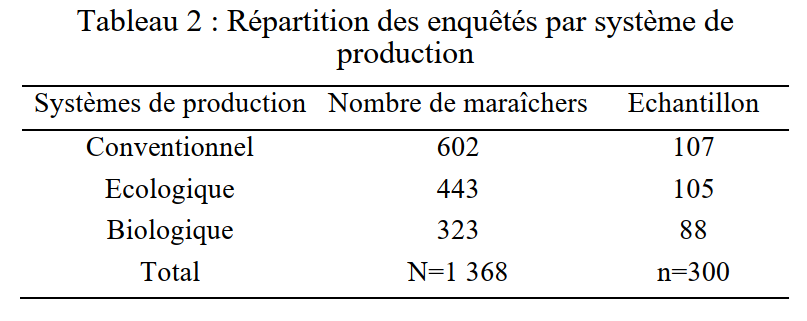Determinants of the adoption of organic vegetable farming systems in southern Benin
DOI:
https://doi.org/10.56109/aup-sna.v12i1.46Keywords:
adoption, organic farming system, determinants, vegetable, BeninAbstract
The behavior changes in terms of food consumption which is accompanied by a significant increase in the consumption of vegetables and especially organic vegetables requires an increase in the production of such organic vegetables.. The present study analyzes the main factors influencing the adoption of organic vegetable production systems in southern Benin. It identifies the intrinsic and extrinsic factors that favor the diffusion of pro-environmental (organic and ecological) vegetable production systems. Quantitative data were collected from 300 producers (including 88 organic vegetables producers certified by the Participatory Guarantee System, 105 ecological vegetables producers and 107 conventional vegetables producers) randomly selected in the municipalities of Sèmè-Kpodji, Ouidah and Abomey-Calavi. These data were analyzed by performing a multinomial Logit regression model. The results reveal that, training on technical itineraries for organic vegetable production (β = 22.94)*** and access to organic inputs ( β = 28.72)*** positively influence the adoption of organic farming system. In contrast, the land tenure mode (β = -21.45)*** influences negatively the adoption of organic farming system. Therefore, establishment of appropriate land policies may strengthen producers’ confidence in investing safely and sustainably in organic vegetable production. In addition, agricultural policies that guarantee availability and accessibility of organic inputs to producers are prerequisites for the adoption of sustainable vegetable production practices. The study suggests that the key policies to strengthen the spread of organic agriculture are those that help farmers access knowledge and secure the recommended inputs for this form of agriculture. The study shows the need to consider both extrinsic factors (socio-economic characteristics and attributes of the external environment) and intrinsic factors (knowledge of the technical itineraries and the requirements of the innovation) when analyzing the decision-making process towards the adoption of pro-environmental production systems.
Downloads
References
Adégbola P., Gardebroek C., 2007. The effect of information sources on technology adoption and modification decisions. Agricultural Economics, 37, 55–65. DOI: https://doi.org/10.1111/j.1574-0862.2007.00222.x
Adékambi S.A., Adégbola P.Y., Arouna A., 2010. Famers’s perception and agricultural technology. The case of botanical extracts and biopesticides in vegetable production in Benin. Contributed paper presented at the joint 48th Agricultural Economists Association of South Africa conference, South Africa, September 19–23, 2010.
Adétonah Sidibé S., Koffi-Tessio E., Coulibaly O., Sessou E., Mensah G.A., 2011. Perceptions et adoption des méthodes alternatives de lutte contre les insectes des cultures maraîchères en zones urbaine et péri-urbaine au Bénin et au Ghana. Bulletin de la Recherche Agronomique du Bénin, N° 69, 1-10.
Adorgloh-Hessou R.A., 2006. Guide pour le développement de l’entreprise de production et de commercialisation de légumes de qualité dans les régions urbaines et périurbaines du Sud-Bénin. Rapport de consultation IITA-Bénin. 82 p.
Ahouangninou C., 2013. Gestion de l'environnement. Environnement, santé et développement durable. Thèse de doctorat, UAC, 349 p.
Amemiya T., 1981. Qualitative response models : a survey. J. Econ. Lit. 19 : 1483- 536, 1981. Stanford University, CA. approach, Water International, 37:3,293-304. http://dx.doi.org/10.1080/02508060.2012.687507. DOI: https://doi.org/10.1080/02508060.2012.687507
Alliance, 2004. Guide pour la création d’une AMAP (Association pour le Maintien de l’Agriculture Paysanne.
Barham B.L., Foltz J.D., Jackson-Smith D., Moon S., 2004. "The dynamics of agricultural biotechnology adoption: Lessons from series rBST use in Wisconsin, 1994–2001."American Journal of Agricultural Economics 86 (1): 61-72. DOI: https://doi.org/10.1111/j.0092-5853.2004.00562.x
Barungi M., Ng’ong’ola D. H., Edriss A., Mugisha J., Waithaka M., et Tukahirwa J., 2013. Factors influencing the adoption of soil erosion control technologies by farmers along the slopes of Mt. Elgon in eastern Uganda. Journal of Sustainable Development, 6, 9–25. DOI: https://doi.org/10.5539/jsd.v6n2p9
Bayendi L.S., Ndoutoume M., Francis F., 2017. Le maraîchage périurbain à Libreville et Owendo (Gabon) : Pratiques culturales et durabilité. Cahiers Agricultures, 26(4). https://doi.org/10.1051/cagri/2017026 DOI: https://doi.org/10.1051/cagri/2017026
Biaou D., Yabi J., Yegbemey R.N., Biaou G., 2016. Performances technique et économique des pratiques culturales de gestion et de conservation de la fertilité des sols en production maraîchère dans la commune de Malanville, Nord Bénin. International Journal of Innovation and Scientific Research, 21(1), 201-211.
Chianu J., Vanlauwe B., Mukalama J., Adesina A., et Sanginga N., 2006. Farmer evaluation of improved soybean varieties being screened in five locations in Kenya: Implications for research and development. African Journal of Agricultural Research, 1, 143–150.
CIMMYT, 1993. The adoption of agricultural technology: a guide for survey design. D.F. Mexico. 88 p.
Coulibaly O., Nkamleu G., 2000. Le choix des méthodes de lutte contre les pestes dans les plantations de cacao et de café au Cameroun. Journal d’économie rurale. 75-85. DOI: https://doi.org/10.3406/ecoru.2000.5208
Daane J., Mongbo R.L., Schamhart R., 1992. Méthodologie de recherche Etrangères, du Commerce Extérieur et de la Coopération Internationale, Direction Générale de la Coopération Internationale (DGCI), Bruxelles, Belgique
Dercon S., Christiaensen L., 2011. Consumption risk, technology adoption and poverty traps: Evidence from Ethiopia. Journal of Development Economics, 96, 159–173. DOI: https://doi.org/10.1016/j.jdeveco.2010.08.003
Desquilbet M., 2018. Organic Food Retailing and the Conventionalisation Debate. Ecological Economics, 150 (February), 194-203. https://doi.org/10.1016/j.ecolecon.2018.04.025 DOI: https://doi.org/10.1016/j.ecolecon.2018.04.025
Dey J., 1981. Gambian women: unequal partners in rice development projects. J. Dev. Stud. 17 (3), 143-151 DOI: https://doi.org/10.1080/00220388108421801
Dimara E., Skuras D., 2003. Adoption of agricultural innovations as a two-stage partial observability process. Agricultural Economics, 28, 187–196. DOI: https://doi.org/10.1111/j.1574-0862.2003.tb00137.x
Doumbia M., Kwadjo K.E., 2009. Pratiques d’utilisation et de gestion des pesticides par les maraîchers en Côte d’Ivoire : Cas de la ville d’Abidjan et deux de ses banlieues (Dabou et Anyama). Journal of Applied Biosciences 18 : 992-1002.
Goswami R., Basu D., 2011. Influence of information networks on farmer’s decision-making in West Bengal. Indian Research Journal of Extension, 11(2), 50.
Haïdara M., 2001. Déterminants socio-économiques des investissements en caféiculture et cacao culture ivoirienne. Rapport d’étude. Ecole Supérieure d'Agronomie, Yamoussoukro, 93 p.
Idrissou A.L., 2002. Les déterminants socio-économiques dans un processus de prise de décision : Cas de l’adoption du coton biologique dans la Circoncision Urbaine de Kandi. Mémoire d’ingénieur agronome. UAC, Bénin.129 p.
Ife Fitz J., Bas K., 2003. La conservation des fruits et des légumes. Série Agrodok No. 3. CTA. Fondation Agromisa, Wageningen. ISBN : 90-77073-32-9. NUGI: 835 ; 94 p.
Kabunga N.S., Dubois T., Qaim M., 2012. Heterogeneous information exposure and technology adoption: The case of tissue culture banana in Kenya. Agricultural Economics, 43, 1-13. DOI: https://doi.org/10.1111/j.1574-0862.2012.00597.x
Kariyasa K., Dewi Y.A., 2013. Analysis of factors affecting adoption of integrated crop management farmer field school (icm-ffs) in swampy areas. International Journal of Food and Agricultural Economics, 1, 29–38.
Laajimi A., Ben Nasr J., 2008. Déterminants économiques de l'adoption de l'agriculture biologique en Tunisie : Cas des exploitations oléicoles de la région de Sfax. In Institut national agronomique de Tunisie (INAT). 17 p. https://www.researchgate.net/publication/278675217
Marra M., Pannell D.J., Abadi Ghadim A., 2003. "The economics of risk, uncertainty and learning in the adoption of new agricultural technologies: where are we on the learning curve?" Agricultural Systems 75(2–3): 215-234. DOI: https://doi.org/10.1016/S0308-521X(02)00066-5
Norris P.E., Kramer R.A., 1990. "The elicitation of subjective probabilities with applications in agricultural economics." Review of Marketing and Agricultural Economics 58 (2-3): 127-147.
Obayelu A.O, Agboyinu O.M., Awotide B.A., 2014. Factors influencing farmers’ choices of adaptation to climate change in Ekiti State, Nigeria. Journal of Agriculture and Environment for International Development, 108, 3–16.
ONU, 2017. Promotion et protection de tous les droits de l’homme, civils, politiques, économiques, sociaux et culturels, y compris le droit au développement. Rapport sur le droit à l’alimentation. Note du secrétariat. GE.17-01059 (F) 140217 160217. A/HRC/34/48. 27 p.
Prager K., and Posthumus H., 2010. "Socio-economic factors influencing farmers’ adoption of soil conservation practices in Europe." Human dimensions of Soil and Water Conservation: A Global Perspective. Nova Science Publishers, Inc, New York: 203-223.
Rabe M.M., Baoua I., Adéoti R., Sitou L., Amadou L., Pittendrigh B., Mahamane S., 2017. Les déterminants socioéconomiques de l’adoption des technologies améliorées de production du niébé diffusées par les champs écoles paysans dans les régions de Maradi et Zinder au Niger. / International Journal of Biological and Chemical Sciences. 11(2): 744 – 756. ISSN 1997-342X (Online), ISSN 1991-8631 (Print). DOI: https://doi.org/10.4314/ijbcs.v11i2.17
Rahman S., 2003. Environmental impacts of modern agricultural technology diffusion in Bangladesh: An analysis of farmers’ perceptions and their determinants. Journal of Environmental Management, 68, 183–191 DOI: https://doi.org/10.1016/S0301-4797(03)00066-5
Rogers E.M., 1983. Diffusion of innovations. Third edition. New York. The free press
Sæthre M.G., Svendsen, Holen N.O., Assogba-Komlan B., Godonou, I. 2011. Pesticide residues analysis for three vegetable crops for urban consumers in Benin. Bioforsk Report, 6: 1 29.
Simon S., Assogba Komlan F., Adjaïto L., Mensah A., Coffi H., Ngouajio M., Martin T., 2014. Efficacy of insect nets for cabbage production and pest management depending on the net removal frequency and microclimate. International Journal of Pest Management, 60, 208-216. DOI: https://doi.org/10.1080/09670874.2014.956844
Spielman D., Ekboir, J., Davis, K., 2009. The art and science of innovation systems inquiry: Applications to sub-Saharan African agriculture. Technology in Society, 31, 399–405. DOI: https://doi.org/10.1016/j.techsoc.2009.10.004
TC., 2009. Présentation du concept AMAP. Retrieved from http://www.terre-citadine.info/wp-content/uploads/2013/07/TC_AMAP_concept.doc.pdf
Van den Berg J., 2013. Socio-economic factors affecting adoption of improved agricultural practices by small scale farmers in South Africa. African Journal of Agricultural Research, 8, 4490–4500. DOI: https://doi.org/10.5897/AJAR12.1025
Venkatesh V., Morris M.G., Davis B., Davis F.D., 2003. User acceptance of information technology : Toward a unified view. MIS Quarterly, 27, 425-478 DOI: https://doi.org/10.2307/30036540
Vincent A., 2016. L’agriculture biologique comme réponse à la pollution de l’eau : apport de la géographie pour comprendre les dynamiques en cours. Université de Lyon
Vodouhè G.T., 2007. Contribution du genre dans la production de légumes sains et perception des maraîchers sur l'utilisation des biopesticides en zones urbaines et péri urbaines du Sud-Bénin. Mémoire d'ingénieur agronome, UAC Bénin. 159 p
Zoundji C.G., Okry F., Vodouhè D.S., Bentley J.W., 2018. Towards sustainable vegetable growing with farmer learning videos in Benin. International Journal of Agricultural Sustainability. 16:1, 54-63, https://doi.org/10.1080/14735903.2018.1428393. DOI: https://doi.org/10.1080/14735903.2018.1428393

Downloads
Published
How to Cite
Issue
Section
Categories
License
Copyright (c) 2022 Gbelidji VODOUHE, Espérance ZOSSOU, Rigobert Coccou TOSSOU, Simplice Davo VODOUHE

This work is licensed under a Creative Commons Attribution 4.0 International License.












